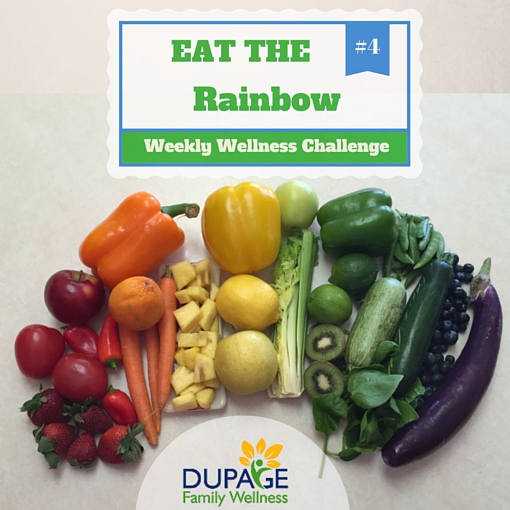
Eat The Rainbow
It is easy it is to get stuck in a rut, eating the same foods. This week, focus on branching out! As you grocery shop, admire at all the colors in the produce department. Buy something new! Fill your cart with foods of different colors.
Why is eating a variety of colors important?
Foods of each color have different nutrients and properties. We need ALL of the colors to get all the nutrients that our bodies need to be healthy.
Red
Red produce is known for its cancer fighting properties. The reds provide an abundance of antioxidants, including high doses of vitamin C, flavonoids, lycopene, and anthocyanin.
Examples of RED: Apples, beets, bell peppers, red cabbage, cayenne peppers, cherries, cranberries, grapes, pomegranates, radicchio, radishes, raspberries, rhubarb, ruby red grapefruit, strawberries, tomatoes, watermelon.
Orange
Orange fruits and vegetables are known for their beta-carotene, which is the precursor to vitamin A. This is essential for night vision and also neutralizes free radicals in the body making it crucial for boosting the immune system. Orange vegetables are another powerhouse of Vitamin C.
Examples of ORANGE: Butternut squash, cantaloupe, carrots, guava, loquats, kumquat, mandarin, mango, nectarines, orange bell pepper, oranges, papaya, persimmon, peach, pumpkin, sweet potato, tangerines, winter squash.
Yellow
We all love this sunny color. Yellow fruits and vegetables are bursting with carotenoids and bioflavanoids and more vitamin C. Studies have found that eating YELLOW is beneficial to your heart, vision, digestion and immune system.
Examples of YELLOW: Lemons, bananas, yellow summer squash, delicata squash, pineapple, star fruit, mangoes, endive, yellow peppers, onions, chamomile, yellow tomatoes, turmeric, mustard seeds, spaghetti squash, Crenshaw melon
Green
If you had to pick one color to provide you with the most nutrient density, green is your color! Eating dark greens are known for:
- Naturally reducing cholesterol
- Providing antioxidants with immune system boosters and anti-cancer properties
- Providing mood boosting B vitamins
- Preventing osteoporosis more effectively than milk. Greens provide calcium along with the potassium, magnesium and other minerals to build strong bones.
Examples of GREEN: Arugula, bok choy, broccoli, cabbage, brussel sprouts, collard greens, lettuces, kale, mustard greens, escarole, turnip greens, beet greens, watercress, spinach, swiss chard, parsley, cilantro, artichokes, green summer squash, cucumbers, kiwi, celery.
Blue / Purple
The USDA has named blueberries the fruit highest in antioxidants. The powerful antioxidants present in blue and purple fruits and veggies help prevent oxidative cell damage, thus reducing the risk of Alzheimer’s, heart disease, and cancer. Anthocyanin in dark blue and purple fruits and vegetables helps to improve memory, and the flavonoids present help to metabolize bacteria in the arteries and improve circulation to reduce the risk of heart disease. Furthermore, the antioxidants neutralize free radicals, preventing cell damage and cancer causing tumors. One added benefit of the blues and purples are the rich flavonoids, which help prevent urinary tract infections.
Examples of BLUE/PURPLE: Blueberries, blackberries, cranberries, eggplant, figs, plums, purple potatoes, grapes, prunes.
This week aim to fill your grocery cart with a rainbow of produce (no, Skittles do not count). Your goal is to eat at least 2 colors at each meal! Let us know how it goes on our facebook page.
Joelle Kurczodyna, NTP

